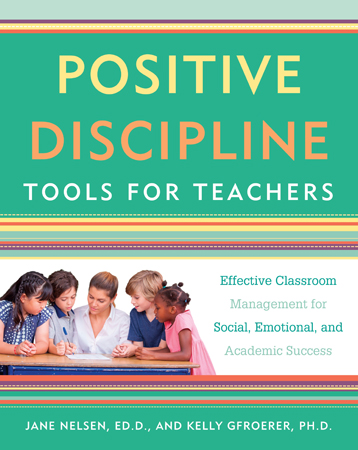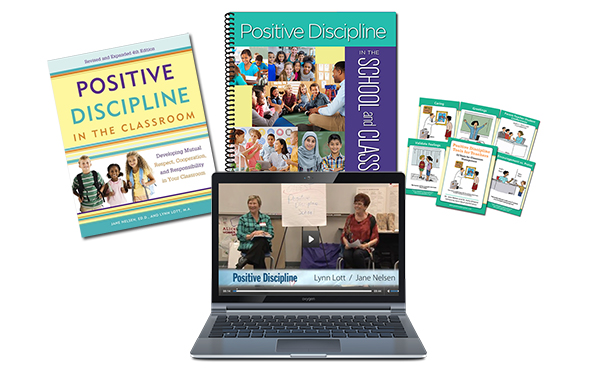Excerpt from Positive Discipline Tools for Teachers
by Dr. Jane Nelsen and Dr. Kelly Gfroerer
Decide what you will do, not what you will try to make students do.
- It is usually most effective to get students involved in decisions. However, sometimes it is appropriate to decide what you will do. Examples:
- “I will post homework for the week on Mondays and give full credit for work turned in on time.”
- “I will teach when you show me you are ready to learn.”
- “It’s time to move on. I will be in the classroom 30 minutes after school to answer any additional questions.”
- Be sure to follow through with what you say you will do. (See the “Follow-Through” tool card.)
There is so much focus in Positive Discipline on getting students involved in solutions, validating their feelings, asking them questions, understanding their behavior, connecting with them, and so on. Do you ever wonder, “What about me?”
Actually, all of this is about you. Involving students in decision making will minimize misbehavior and will increase your joy as a teacher. When students feel encouraged, you will feel encouraged as well.
And there are times when you don’t need to get students involved. You can simply decide what you are going to do. Kindly and firmly let your students know, and kindly and firmly follow through. Notice the “and” in “kindly and firmly.” It is best if you get students involved more often than you decide for them, but trust your judgment that you will know which to use when.
One day Jane Nelsen was observing a fourth-grade classroom, and the students were being a little disruptive. The teacher got very quiet and seemed to be staring at the back wall, where there was a clock. The kids started whispering, “She is counting. Be quiet.” Soon all the students were sitting quietly at their desks and the teacher started her lesson.
Later Jane asked, “How high do you count and what do you do after you get there?”
The teacher said, “Oh, I’m not counting. I have just decided I won’t teach until they are ready. They think I’m counting, and they get quiet. It works for me.”
The tool Decide What You Will Do helps teachers successfully implement kind and firm classroom management.
Tool in Action from Eureka, Illinois
All of us have classes that we will always remember. Mine is a group of first graders who were super-smart, creative, and powerful! The majority of these kids were either firstborn or only children, and they were used to running the show. I remember sometimes feeling that they could do a better job of organizing the day than I could!
By the end of the day, I would feel bone-weary, with my throat scratchy and my voice tired from trying to compete for airtime with these kids. I decided to try something different, to decide what I would do rather than trying to change what the kids were doing.
I brought my library book from home, and I told my class that I was no longer willing to raise my voice to be heard. Anytime they weren’t listening, I would go to my desk, take out my book, and read until they were ready. They looked a little surprised, and the day started off pretty well. It seemed that even the heads-up about what I planned to do was helpful to them, and to me. But sure enough, later in the day, several of them interrupted with side conversations, talking over one another, voices louder and louder, and I almost forgot my plan. However, I caught my- self before raising my voice and entering the fray. I moved over to my desk, took out my book, and began to read. Ah, heaven! It didn’t take long for the kids to notice and for a chorus of shhh to follow. Whispered terse directions came from the kid leaders, and they all quieted down. I waited a minute, then quietly put my book down and returned to the group with no comment about their behavior.
I was amazed at how quickly my actions impacted the behavior of the children. I kept my self-respect, respected others in the group, and experienced increased energy. It set a great precedent for handling classroom noise and distractions. One of the best parts for me was feeling good at the end of the day about the way I had conducted myself.
—Dina Emser, former director of Blooming Grove Academy, Certified Positive Discipline Lead Trainer
Classroom Educator Certification Training
Hundreds of schools worldwide use these amazingly effective Positive Discipline strategies for restoring order and civility in today’s turbulent classrooms. Now you too can use this philosophy as a foundation for fostering cooperation, problem-solving skills, and mutual respect. Just imagine, instead spending your time energy trying to manage and control misbehavior, you can enjoy teaching. Instead of confronting apathy, you will enjoy motivated, eager, engaged students! Inside you’ll discover how to:
- Create a classroom climate based on community and cooperation that enhances academic learning.
- Use encouragement to increase students’ intrinsic motivation.
- Instill valuable social and emotional life skills and positive behavior through the use of class meetings.
- Understand the motivation behind students’ behavior instead of looking for causes.
And much more!
13 Hours of CE Credit available.




No Comments yet!